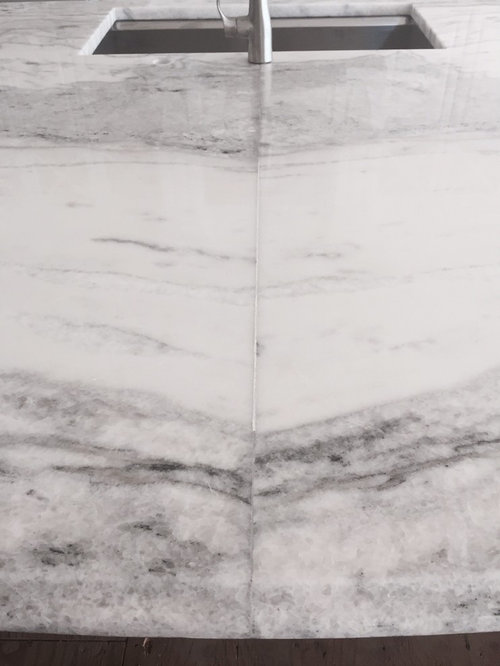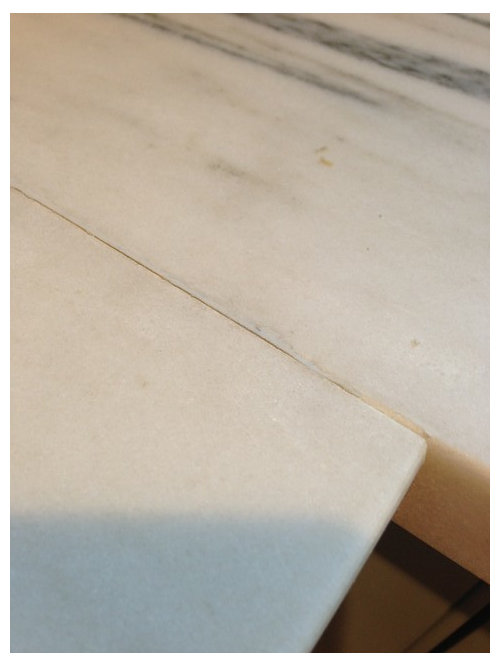Marble countertops are renowned for their timeless beauty and elegance, making them a popular choice for homeowners and designers alike. However, one of the challenges in installing marble countertops is managing the seams where two pieces of marble meet. Seams are necessary due to the size limitations of marble slabs and the need to fit the stone into specific spaces in a kitchen or bathroom. Properly handling these seams is crucial to maintaining the aesthetic appeal and structural integrity of the countertop.
When fabricating marble countertops, it’s essential to carefully plan the layout to minimize the number and visibility of seams. The positioning of the seams should take into account the natural veining and patterns of the marble, as well as the overall design of the space. Ideally, seams should be placed in less conspicuous areas, such as corners or near sinks, where they are less likely to draw attention. Additionally, the fabricator should match the color and pattern of the adjoining pieces as closely as possible to create a seamless appearance.
The quality of the seam is greatly influenced by the precision of the cut and the skill of the installer. Advanced cutting technology, such as water jet cutting, allows for more precise cuts that result in tighter seams. During installation, the pieces of marble must be carefully aligned and leveled to ensure that the seam is as tight and even as possible. Any gaps or unevenness can not only detract from the appearance of the countertop but also create weak points that can lead to damage over time.
Once the marble pieces are in place, the seams are filled with a special adhesive, typically a polyester resin or epoxy. This adhesive can be tinted to match the color of the marble, helping to blend the seam with the surrounding stone. The adhesive is then cured and polished to create a smooth, even surface. In some cases, additional polishing of the entire countertop may be necessary to achieve a uniform finish.
One common issue with marble countertop seams is discoloration over time. This can occur if the adhesive used in the seam absorbs moisture or other substances, leading to a noticeable color difference between the seam and the surrounding marble. To prevent this, it’s important to use high-quality adhesives and sealants specifically designed for use with marble. Regular maintenance, including resealing the countertop as recommended by the manufacturer, can also help protect the seams and the marble itself.

Another consideration is the structural integrity of the seam. Because marble is a natural stone, it can be prone to cracking, especially along seams. To enhance the strength of the seam, fabricators often use mechanical fasteners, such as metal rods or clips, to hold the pieces of marble together. These fasteners are embedded in the stone and hidden from view, providing additional support without compromising the appearance of the countertop.
Thermal expansion and contraction can also affect marble countertop seams. Marble, like all natural stones, can expand and contract with temperature changes. This movement can put stress on the seams, potentially causing them to crack or separate. To mitigate this risk, it’s important to maintain a stable indoor environment and avoid exposing the countertop to extreme temperature changes.
The use of proper support is critical for the longevity of marble countertops and their seams. Adequate support beneath the countertop, particularly near seams, helps distribute the weight of the marble evenly and prevents sagging or shifting. This support can come in the form of cabinets, brackets, or additional substructure designed to hold the weight of the stone.

Cleaning and care routines also play a vital role in maintaining the appearance and durability of marble countertop seams. Abrasive cleaners or harsh chemicals can damage the adhesive and the marble itself, leading to discoloration or weakening of the seams. Instead, it’s recommended to use mild, pH-neutral cleaners and soft cloths for regular cleaning. Wiping up spills promptly and avoiding placing hot items directly on the countertop can further protect the seams from damage.
Despite the challenges, well-installed marble countertop seams can be nearly invisible, contributing to the overall elegance of the surface. The key is careful planning, skilled fabrication, and meticulous installation. By understanding the properties of marble and the best practices for working with it, homeowners can enjoy the beauty of marble countertops with seams that are discreet and durable.
In addition to the aesthetic and functional aspects, cost is another factor to consider when dealing with marble countertop seams. High-quality materials, advanced fabrication techniques, and skilled labor can increase the overall cost of the countertop. However, investing in these aspects can result in a more beautiful and longer-lasting installation, ultimately providing better value in the long run.
The environmental impact of marble countertop seams is another consideration. The extraction, transportation, and fabrication of marble have environmental costs, and minimizing waste during the fabrication process can help reduce these impacts. Efficient use of marble slabs, thoughtful seam placement, and recycling of leftover materials can all contribute to a more sustainable approach.

When choosing a fabricator and installer for marble countertops, it’s important to research and select professionals with experience and a strong reputation for quality work. Reading reviews, visiting showrooms, and viewing examples of previous installations can provide insight into their capabilities and attention to detail. A skilled professional will not only create a beautiful countertop but also ensure that the seams are as inconspicuous and durable as possible.
For homeowners who are particularly concerned about the visibility of seams, some alternative materials and techniques can be considered. For example, engineered stone products, such as quartz, can offer a similar look to marble with fewer seams or even seamless options. Additionally, certain marble finishes, such as honed or leathered, can help reduce the visibility of seams by minimizing the reflective surface of the stone.
Ultimately, the success of marble countertop seams depends on a combination of proper material selection, expert fabrication, precise installation, and regular maintenance. By paying attention to these details, homeowners can enjoy the luxurious look of marble countertops with seams that are both functional and visually appealing.

Common Mistakes to Avoid:
One of the most common mistakes when dealing with marble countertop seams is poor seam placement. Placing seams in highly visible areas or across major veining can disrupt the flow of the marble’s natural pattern and detract from its beauty. To avoid this, seams should be planned carefully, considering both the aesthetics and functionality of the space.
Another frequent mistake is using low-quality adhesives or not properly tinting the adhesive to match the marble. This can result in seams that are highly visible and may discolor over time. Using high-quality, color-matched adhesives is crucial for achieving a seamless appearance.
Improper support is another common issue that can lead to problems with marble countertop seams. Without adequate support, the weight of the marble can cause the seams to crack or separate. Ensuring that the countertop is properly supported, especially near seams, is essential for maintaining its structural integrity.
Failure to maintain a stable indoor environment can also lead to issues with marble seams. Extreme temperature changes can cause the marble to expand and contract, putting stress on the seams. Maintaining a consistent temperature and avoiding placing hot items directly on the countertop can help prevent this.
Neglecting regular maintenance, such as resealing the countertop, can also lead to problems. Over time, the protective sealant can wear away, leaving the seams and the marble vulnerable to moisture and staining. Regular maintenance, including resealing as recommended by the manufacturer, is essential for keeping marble countertops and their seams in good condition.

Why do marble countertops have seams?
Marble countertops have seams because the size of marble slabs is limited, and larger countertops require multiple pieces of marble to cover the entire surface. Seams are necessary to fit the marble into specific spaces and to accommodate the natural veining and patterns of the stone. Properly placed and well-crafted seams can be discreet and blend seamlessly with the rest of the countertop.
How can I make marble countertop seams less visible?
Making marble countertop seams less visible involves careful planning, precise fabrication, and skilled installation. The seams should be placed in less conspicuous areas, and the color and pattern of adjoining pieces should be matched as closely as possible. Using high-quality, color-matched adhesives and ensuring that the pieces are tightly aligned and leveled can also help minimize the visibility of seams.
What should I do if my marble countertop seam discolors over time?
If your marble countertop seam discolors over time, it is likely due to the absorption of moisture or other substances by the adhesive. To prevent this, use high-quality adhesives and sealants designed for use with marble. Regular maintenance, including resealing the countertop as recommended, can help protect the seams. If discoloration occurs, a professional fabricator may be able to repair or replace the affected seam.
Can marble countertop seams crack, and how can I prevent this?
Yes, marble countertop seams can crack, especially if the marble is subjected to stress or if the seams are not properly supported. To prevent cracking, ensure that the countertop is adequately supported, particularly near the seams. Avoid exposing the countertop to extreme temperature changes and handle it with care to avoid placing excessive weight or pressure on the seams.
How often should I reseal my marble countertop to maintain the seams?
The frequency of resealing your marble countertop depends on the type of sealant used and the amount of use the countertop receives. Generally, it is recommended to reseal marble countertops every 6 to 12 months. Regular resealing helps protect the marble and the seams from moisture, staining, and other damage, ensuring that the countertop remains beautiful and durable over time.

Quartz countertops seams Modern kitchen quartz, Quartz kitchen

Countertops And The Truth About Seams – Rocktops

Anyone’s marble/granite seam separate like this?

Related articles:
- DIY Refinishing Cultured Marble Countertops
- Marble Countertops In Bathrooms
- Cultured Marble Countertops
- Gray Kitchen Cabinets Marble Countertops
- Modern Kitchen Marble Countertops
- Refinish Cultured Marble Countertop
- Carrara Marble Countertops Bathroom
- Marble Countertops Types
- How To Refinish Marble Countertops
- White Gray Marble Countertops